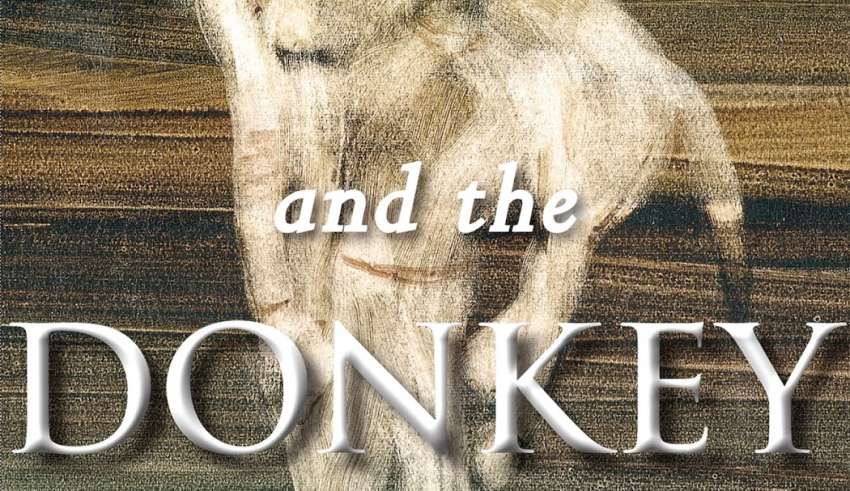by Peter Cochrane
Preface to the 2014 anniversary edition of Simpson and the Donkey. The Making of a Legend (Melbourne University Press). Peter Cochrane 2014.
 SOME legends go on forever. Age does not weary them, nor do the years condemn. They are entirely free of the mortal limitations of the hero they celebrate. They are distinguished by longevity, by the way they resonate in a culture years, decades, even centuries after the hero is long gone. So it is with the legend of the man with the donkey, John Simpson Kirkpatrick. Almost 100 years since Simpson was killed at Gallipoli, the legend soldiers on. And 22 years since this book was first published, in 1992, there has been no sign of it letting up.
SOME legends go on forever. Age does not weary them, nor do the years condemn. They are entirely free of the mortal limitations of the hero they celebrate. They are distinguished by longevity, by the way they resonate in a culture years, decades, even centuries after the hero is long gone. So it is with the legend of the man with the donkey, John Simpson Kirkpatrick. Almost 100 years since Simpson was killed at Gallipoli, the legend soldiers on. And 22 years since this book was first published, in 1992, there has been no sign of it letting up.
In that time there has been a film, a play, a musical, more books for adults and children, a lavishly funded essay prize and another life-sized statue to grace the gardens of a capital city, this time Adelaide. The image appeared on a $5 commemorative coin in 1995 and it was front and centre on the $100 bill released in 1996. By that time Simpson had acquired a fast-growing presence on the internet and today thousands of websites celebrate or dispute the deeds of the man with the donkey, while passionate bloggers argue the toss over the details of his heroism and the meaning of it all. That passion translates to the real world in the form of petitions to the Commonwealth Parliament requesting a posthumous Victoria Cross for the man; the Defence Honours Tribunal has recently concluded a year-long investigation into that possibility.
Tourism, too, has been cashing in. Simpson figures prominently in the marketing of “the Gallipoli experience”. Folklore and commerce are mutual beneficiaries here. There have been endless tellings and retellings of the tale and the embellishments keep on coming, the latest from a Turkish tour guide, a man called Ali Efes. At Gallipoli, Ali takes Australians to Simpson’s grave and tells of how the man with the donkey ferried wounded Turks back to the Turkish lines.
Like Ali Efes, some of our politicians have also been overwhelmed by the universal human qualities of the story. They have played no small part in keeping the legend in both Hansard and the headlines. As the 2001 federal election loomed, Labor Party MPs introduced a bill to award a retrospective VC to the man with the donkey. These MPs took up the cause in the spirit of righting a terrible wrong. The ethics of politicians invading the award process seemed to worry them not a jot. It was all about emotion: “A man who has become the very epitome of Anzac,” said Jill Hall, Labor member for Shortland in New South Wales. It was all about symbolism too. The arguments for a retrospective VC strayed far from merit based on first-hand evidence of extraordinary valour. “I say bugger the paperwork – let’s reward an iconic figure and give John Simpson Kirkpatrick a posthumous VC,” said Harry Quick, Labor member for Franklin in Tasmania. The Liberal Member for Parramatta, Ross Cameron, agreed: “Simpson is clearly an enormous figure in the national psyche … He is the most celebrated, the most emblematic, and the most iconic figure in Australian military history,” he told the parliament.
The cause carried into the 2001 federal election with the Labor Party in Opposition vowing to legislate a VC for the man with the donkey if elected. They weren’t elected and John Howard, in his third term as prime minister, was not inclined to interfere with the hallowed procedures for the highest award for valour in the land.
But Howard was alert to the symbolic utility of the famous icon, and Simpson fitted perfectly into his vision for a national day that would unify Australia in a traditionally conservative way. Australia Day in the bicentennial year of 1988 had incited more division than unity. Celebrating our colonial origins seemed only to bring discord, focused on issues such as invasion, dispossession, stolen children and land rights, and that discord carried into the 1990s in the form of the “History Wars”. When Howard came into government in 1996 he was intent upon ridding Australians of the “self-laceration” and “guilt” associated with our colonial history, preferring instead to commemorate and celebrate our military past and focusing that celebration on Anzac Day.
The Prime Minister was adamant that government had a role to play in pressing this cause into schools. Curriculum materials for Anzac history were lavishly funded as the Department of Veterans’ Affairs was transformed into an educational resource facility centred on the idea that our national history is essentially a story of heroic military engagements abroad, none more important than the founding narrative at Gallipoli in 1915. The lucrative Simpson essay prize was established for year 9 and 10 students in 1999 – with prizes including trips to Gallipoli – and in 2004 the PM was persuaded that “values” were flagging in public schools and Simpson would do nicely as the official icon for the restoration.
The National Framework for Values Education in Australian Schools was released in May 2005 by the Minister for Education Brendan Nelson. The nine values the government wanted taught in Australian schools were headed by “care and compassion” and listed on a big poster that schools were required to display prominently to receive a share of $33 billion in federal funding. The values were superimposed over an image of Simpson and the donkey rescuing a wounded soldier. Beneath the icon was an out-of-context quotation from nineteenth-century English novelist George Eliot: “Character is destiny.”
The Minister for Education hyped up the cause. He said the story of the unarmed Simpson and his donkey bearing a wounded soldier to safety had become a legend that represented everything that Australia aspired to be. He said the values listed on the poster must be taught in all schools, Islamic schools included, and “If people don’t want to accept and embrace those values then they ought to clear off, I don’t care where they’re from”.
Criticisms came thick and fast. Many Australians indicated they did not want the government dictating how school children should think and some had reservations about the use of Simpson as the pin-up figure. Critics said he represented, at best, selective and nostalgic truths about the landing at Gallipoli. An editorial in The Age argued “the 90 year old imperialist tale of Simpson and his donkey is arguably of marginal relevance in 21st century Australia”. The Age called the choice a “simplistic Boy’s Own Annual vision of Australia”.
Educators spoke out too. The headmaster at Melbourne Grammar School was appalled by Nelson’s comments and was not enthused by Simpson, while Andrew Blair, President of the Secondary Principals Association, objected strongly to having Simpson as the values icon.
Why, he asked, “an image that is grounded in heroism in conflict” when an image “about tolerance and trust” would be much more suitable? The Simpson image, he said, was “of yesteryear” and “too blokey”.
Questioning the use of Simpson in the values push stirred Minister Nelson to dizzy heights. “He [Simpson] represents everything at the heart of what it means to be Australian,” he said, and “everything that we should strive to be as a nation.” He said that under no circumstances would he remove the image from the values project: “Our fundamental value is that we will place the interest and welfare of other human beings ahead of our own – that’s what Simpson and his donkey represents,” he insisted.
But while Nelson had again called the legend into national prominence, he had also failed his education portfolio in a dismal fashion. “Character is destiny” sounds good, a nifty motto suggesting our course in this world is entirely in our hands. Yet it hardly applies to Simpson, whose main objective was to get home, to England, and his destiny was arguably determined not by his character but by forces over which he had no control at all.
Students who were told to study the values poster needed to know that destiny is at least a questionable entity and that character alone, sad as it may seem, does not chart our course into the future.
George Eliot’s marvellous insight into this simple truth – evoking Hamlet in the process – can be found in book six, chapter six of The Mill on the Floss. Perhaps the Minister snatched the three-word quotation from his desk calendar and for that reason had no idea that Eliot was in fact mocking the notion that character is destiny. Had Nelson bothered to read the quotation in context he might have understood Eliot’s sarcasm. She actually called it “a questionable aphorism” and her narrative explained why it is questionable. Students could have learnt from this but instead they were misled. It is hard to think of a more cruel and deceptive aphorism when applied to the front line soldiers of the Great War, Simpson included.
Perhaps Minister Nelson was not wholly inspired by Eliot, an atheist like Simpson, and a woman who lived outside the norms of respectable English society by co-habiting with a man whom she never married. Perhaps the inspiration, in the first instance, came from somewhere else?
In 2004, US Republican Senator John McCain completed a book called Character is Destiny (published 2005) to inspire American children with correct moral values as illustrated by heroic true-life stories. Nelson’s values poster for schools far more closely echoes McCain than Eliot and it most certainly misrepresents Simpson and what he stood for. The entire exercise provides a dismal example of how Simpson can be so routinely misused by people with political agendas.
The most persistent misuse concerns Simpson’s politics. He was a class-conscious radical, as the cache of letters analysed in chapter one [of Simpson and the Donkey: The Making of a Legend] clearly reveals. Anyone seriously in search of the so-called “real man” has to subject these letters to the most rigorous scrutiny, accepting painful engagement with evidence that might not be welcome and weighing the man in all the complexity that resides within those precious letters. The classic case of denial and distortion in this regard was the unctuous Sir Irving Benson who, in the 1960s, set a standard for bowdlerisation that I naively thought would never be matched. But I was wrong. Since 1992 the politicians and military historians who have made a hobbyhorse of Simpson have continued to operate in the Benson tradition, professing a passionate interest in the “real man” while systematically evading serious engagement with his letters. Simpson is rendered a caricature consistent with their own agendas. The biographical opportunity to understand a radical seaman from northern England in the contexts of his travels, his war and, indeed, his writing, is entirely and happily passed over.
The enthusiasts who follow Simpson’s trail practise a kind of “character is destiny” approach to history. They expect to find in the hero all the necessary conditions for his fame. Thus they see about as much as you would see in a trench; that is, nothing of the big picture, nothing of the social and political forces that raised the legend to national prominence and sustained it thereafter – the forces that are the subject of this book.
From one generation to another and from one official inquiry or parliamentary push to the next, the debate about Simpson continues to pore over much the same terrain — the fine detail in the military record – the protagonists now and then startled by the discovery of a new fact. In this regard the legend has become a banal and tiresome feuding, perhaps best demonstrated by the self-avowed “expert” who published his case against a VC in 2006, declaring that the man with the donkey was an ill-disciplined deserter who shirked the strenuous and more dangerous work of stretcher-bearing. Six years later, after a lot more research, he presented his case against himself to the Defence Honours and Awards Tribunal, arguing that Simpson was disciplined, dutiful, decent, hard-working and brave – but no more so than other stretcher-bearers. The Tribunal agreed. Simpson would not be awarded a posthumous VC.
This preface to a new edition of Simpson and the Donkey provides an opportunity to stress several points, since the Simpson obsessives – whether MPs, political bloggers or hobby historians – seem happy to practise deception or live in denial. Firstly, the Simpson legend was the creation of a despicable propaganda offensive that the man himself would have condemned as surely as he would have voted “No” in the conscription referendums had he lived.
The legend of the man with the donkey was a mere cipher, one tale among many thousands that were aimed at compelling men to enlist to fight abroad. The incessant message was “War is hell, but it is splendid”. Students of Simpson need to know this. They need to know that in history, context is everything and the context for the Simpson legend is textual and political it is not Shrapnel Gully. If we cannot see the part within the whole then we are truly lost. If we cannot locate the legend in its print context then we cannot begin to understand it.
Secondly, Simpson is a distinctive figure: with his donkey bearing the wounded soldier alongside him, the connotations are both Christ-like and pitiful. That, surely, singled him out. But in every other way, the tales told about him are more or less interchangeable with thousands of other propaganda tales. The tropes are widely shared – contempt for shrapnel, scorn for danger, selfless and sacrificial behaviour, no risk too great, smiling even unto death “glorious death” and so on.
The point is simple – the Simpson legend was a particular distillation of an epic model of swagger and bravado created and perpetuated by the print media, overseen by government and the censors, and attributed to Australian soldiers in general. That epic model was heroic rhetoric for cannon-fodder, a grotesque romanticisation of Australian soldiers in battle and death.
Finally, the apparent absence of a decoration or military honour for Simpson was a vital part of the legend, at least while living memory still reached back to the First World War. When a statue of the man with the donkey was unveiled at the Shrine of Remembrance in Melbourne in 1933, The Argus ran a poem that celebrated Simpson as the “type” who stood for the unsung heroes, “all the unnamed, forgot by fame”. The legend signified a collective, unsung heroism and in this regard it was profoundly and movingly egalitarian. But time has erased that memory and the passionate advocates for a posthumous VC forge on, oblivious. The legend of the man with the donkey continues to be made and remade more in denial of the historical record than in recognition of it.







